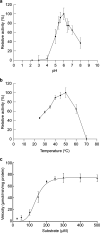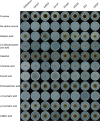Discovery and Functional Analysis of a Salicylic Acid Hydroxylase from Aspergillus niger
- PMID: 33397706
- PMCID: PMC8105025
- DOI: 10.1128/AEM.02701-20
Discovery and Functional Analysis of a Salicylic Acid Hydroxylase from Aspergillus niger
Abstract
Salicylic acid plays an important role in the plant immune response, and its degradation is therefore important for plant-pathogenic fungi. However, many nonpathogenic microorganisms can also degrade salicylic acid. In the filamentous fungus Aspergillus niger, two salicylic acid metabolic pathways have been suggested. The first pathway converts salicylic acid to catechol by a salicylate hydroxylase (ShyA). In the second pathway, salicylic acid is 3-hydroxylated to 2,3-dihydroxybenzoic acid, followed by decarboxylation to catechol by 2,3-dihydroxybenzoate decarboxylase (DhbA). A. niger cleaves the aromatic ring of catechol catalyzed by catechol 1,2-dioxygenase (CrcA) to form cis,cis-muconic acid. However, the identification and role of the genes and characterization of the enzymes involved in these pathways are lacking. In this study, we used transcriptome data of A. niger grown on salicylic acid to identify genes (shyA and crcA) involved in salicylic acid metabolism. Heterologous production in Escherichia coli followed by biochemical characterization confirmed the function of ShyA and CrcA. The combination of ShyA and CrcA demonstrated that cis,cis-muconic acid can be produced from salicylic acid. In addition, the in vivo roles of shyA, dhbA, and crcA were studied by creating A. niger deletion mutants which revealed the role of these genes in the fungal metabolism of salicylic acid.IMPORTANCE Nonrenewable petroleum sources are being depleted, and therefore, alternative sources are needed. Plant biomass is one of the most abundant renewable sources on Earth and is efficiently degraded by fungi. In order to utilize plant biomass efficiently, knowledge about the fungal metabolic pathways and the genes and enzymes involved is essential to create efficient strategies for producing valuable compounds such as cis,cis-muconic acid. cis,cis-Muconic acid is an important platform chemical that is used to synthesize nylon, polyethylene terephthalate (PET), polyurethane, resins, and lubricants. Currently, cis,cis-muconic acid is mainly produced through chemical synthesis from petroleum-based chemicals. Here, we show that two enzymes from fungi can be used to produce cis,cis-muconic acid from salicylic acid and contributes in creating alternative methods for the production of platform chemicals.
Keywords: catechol-dioxygenase; chemical building block; intradiol ring fission; platform chemical; salicylic acid metabolism.
Copyright © 2021 American Society for Microbiology.
Figures






Similar articles
-
Production of Protocatechuic Acid from p-Hydroxyphenyl (H) Units and Related Aromatic Compounds Using an Aspergillus niger Cell Factory.mBio. 2021 Jun 29;12(3):e0039121. doi: 10.1128/mBio.00391-21. Epub 2021 Jun 22. mBio. 2021. PMID: 34154420 Free PMC article.
-
Four Aromatic Intradiol Ring Cleavage Dioxygenases from Aspergillus niger.Appl Environ Microbiol. 2019 Nov 14;85(23):e01786-19. doi: 10.1128/AEM.01786-19. Print 2019 Dec 1. Appl Environ Microbiol. 2019. PMID: 31540981 Free PMC article.
-
Production of muconic acid in plants.Metab Eng. 2018 Mar;46:13-19. doi: 10.1016/j.ymben.2018.02.002. Epub 2018 Feb 21. Metab Eng. 2018. PMID: 29474840
-
[Mechanisms and regulation of enzymatic hydrolysis of cellulose in filamentous fungi: classical cases and new models].Rev Iberoam Micol. 2015 Jan-Mar;32(1):1-12. doi: 10.1016/j.riam.2013.10.009. Epub 2014 Mar 7. Rev Iberoam Micol. 2015. PMID: 24607657 Review. Spanish.
-
Emerging biotechnologies for production of itaconic acid and its applications as a platform chemical.J Ind Microbiol Biotechnol. 2017 Feb;44(2):303-315. doi: 10.1007/s10295-016-1878-8. Epub 2016 Dec 8. J Ind Microbiol Biotechnol. 2017. PMID: 27933436 Review.
Cited by
-
Proteome-Wide Analysis of Lysine 2-Hydroxyisobutyrylation in Aspergillus niger in Peanuts.Front Microbiol. 2021 Aug 18;12:719337. doi: 10.3389/fmicb.2021.719337. eCollection 2021. Front Microbiol. 2021. PMID: 34489910 Free PMC article.
-
Transcriptome analysis of Aspergillus oryzae RIB40 under chemical stress reveals mechanisms of adaptation to fungistatic compounds of lignocellulosic side streams.Biotechnol Biofuels Bioprod. 2025 Aug 8;18(1):89. doi: 10.1186/s13068-025-02688-5. Biotechnol Biofuels Bioprod. 2025. PMID: 40781683 Free PMC article.
-
Production of Protocatechuic Acid from p-Hydroxyphenyl (H) Units and Related Aromatic Compounds Using an Aspergillus niger Cell Factory.mBio. 2021 Jun 29;12(3):e0039121. doi: 10.1128/mBio.00391-21. Epub 2021 Jun 22. mBio. 2021. PMID: 34154420 Free PMC article.
-
Filamentous fungi as emerging cell factories for the production of aromatic compounds.Fungal Biol Biotechnol. 2024 Nov 14;11(1):19. doi: 10.1186/s40694-024-00188-z. Fungal Biol Biotechnol. 2024. PMID: 39543771 Free PMC article. Review.
-
Polyextremotolerant, opportunistic, and melanin-driven resilient black yeast Exophiala dermatitidis in environmental and clinical contexts.Sci Rep. 2025 Feb 22;15(1):6472. doi: 10.1038/s41598-025-88595-z. Sci Rep. 2025. PMID: 39987208 Free PMC article.
References
-
- Milstein O, Vered Y, Shragina L, Gressel J, Flowers HM, Hüttermann A. 1983. Metabolism of lignin related aromatic compounds by Aspergillus japonicus. Arch Microbiol 135:147–154. doi:10.1007/BF00408025. - DOI
Publication types
MeSH terms
Substances
LinkOut - more resources
Full Text Sources
Other Literature Sources

